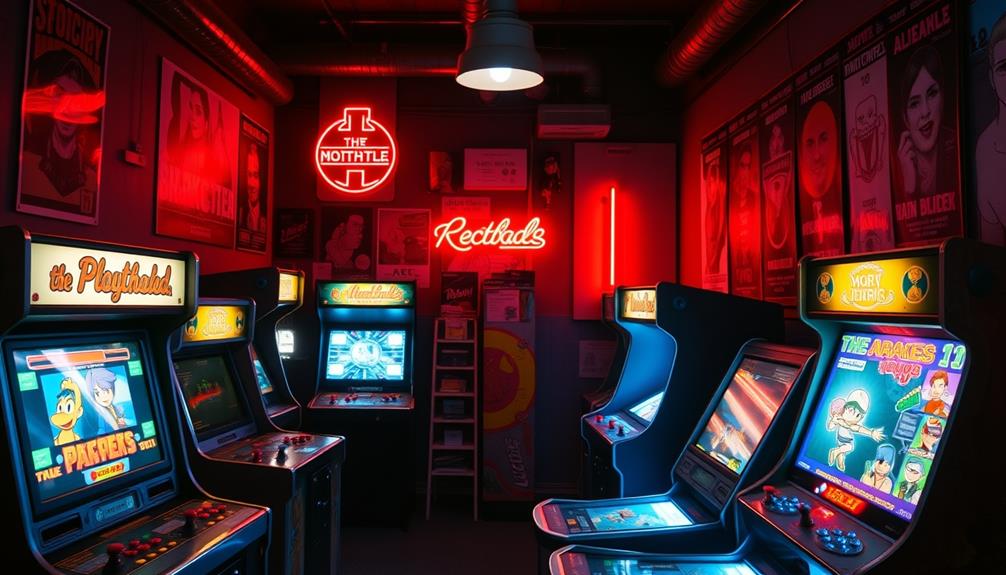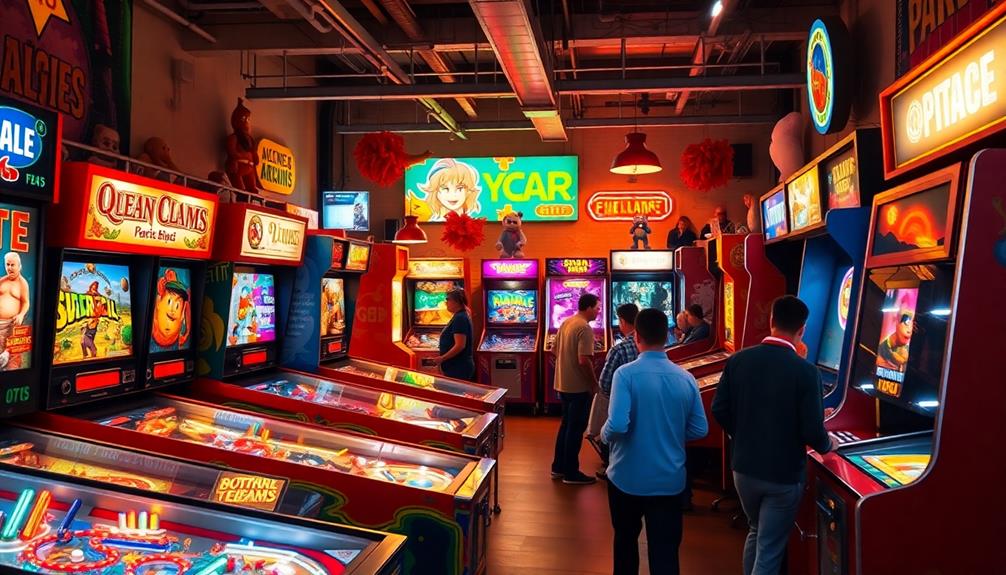Old arcade games are commonly referred to as classic arcade games, representing a nostalgic era of gaming spanning from the late 1970s to the early 1980s. Well-known titles such as Pac-Man, Donkey Kong, and Space Invaders were favorites among players due to their uncomplicated gameplay and compelling mechanics. These games not only influenced the arcade gaming industry but also had a significant impact on popular culture. Their innovative design and mechanics served as a foundation for numerous contemporary video games. For those interested in exploring the charm of these games, delving into their influence and legacy may provide intriguing insights.
Key Takeaways
- Old arcade games are often referred to as "classic arcade games," originating from the late 1970s to early 1980s.
- Iconic titles like *Pac-Man*, *Donkey Kong*, and *Space Invaders* are quintessential examples of classic arcade games.
- These games are characterized by simple mechanics and engaging gameplay, making them widely accessible to players of all ages.
- The golden age of arcade gaming saw a surge in popularity, leading to the establishment of dedicated arcades.
- Nostalgia for these vintage games has led to a revival, with venues like barcades celebrating their cultural significance.
Definition of Classic Arcade Games
Classic arcade games, often known as vintage or retro titles, emerged during the golden age of arcade gaming from the late 1970s to early 1980s. These games typically feature simple mechanics and engaging gameplay, making them accessible to a wide audience.
Many of these classic games, including early pinball machines, were housed in coin-operated machines, which became staples in entertainment venues and led to the rise of thousands of arcades across North America. The evolution of arcade gaming is closely tied to the innovations in pinball machine design, showcasing the creativity of the era.
Iconic examples like *Pong*, *Space Invaders*, *Pac-Man*, and *Donkey Kong* greatly shaped the gaming landscape during this era. These titles not only entertained countless players but also set the foundation for future gaming innovations. Their competitive nature often encouraged quick sessions, bringing people together and creating a vibrant social scene around arcade gaming.
The cultural significance of classic arcade games can't be overstated. They influenced not just the evolution of video gaming but also left a lasting impact on popular culture.
Today, you can still feel their relevance, as many vintage arcade games are celebrated and enjoyed by new generations, reminding us of the joy and excitement that defined the golden age of arcade gaming.
History of Arcade Games
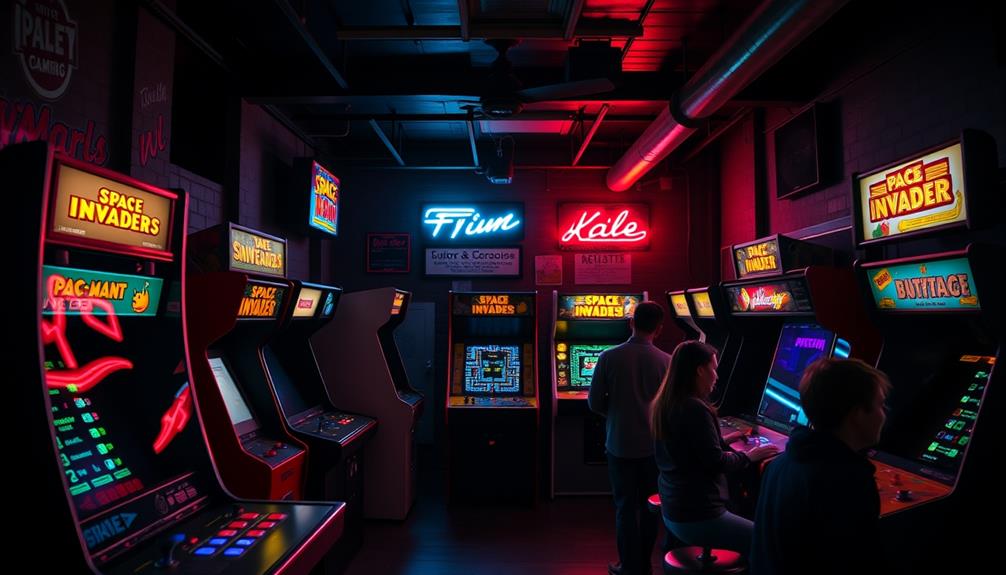
You might be surprised to learn that arcade games began with *Computer Space* in 1971, setting the stage for a new entertainment era.
During this time, innovations in gaming technology started to emerge, paving the way for more engaging and complex experiences.
From there, the industry exploded during the golden age, fueled by groundbreaking titles like *Space Invaders* and *Pac-Man*.
As technology advanced, the shift from basic electro-mechanical games to vibrant video games transformed the gaming landscape forever.
Today, enthusiasts can enjoy a variety of options, including best arcade machines for home game rooms.
Origins of Arcade Games
The origins of arcade games stretch back to the late 19th century, when skill-based carnival games and coin-operated machines laid the groundwork for what would become a vibrant gaming culture.
These early forms of entertainment not only captured the public's attention but also set the stage for the financial aspects of gaming, such as the concept of budgeting for entertainment.
As you explore this fascinating history, you'll see how these early games evolved into the arcade phenomenon we recognize today.
- The first arcade game, Computer Space debuted in 1971, inspired by MIT's *Spacewar!* from 1961.
- The release of Pong in 1972 marked a turning point, popularizing arcade gaming and reaching a broader audience.
- The golden age of arcades kicked off with Space Invaders in 1978, setting the stage for the shoot-em-up genre.
- Iconic titles like Pac-Man (1980) and *Donkey Kong* (1981) diversified the gaming landscape, establishing new genres and solidifying the arcade's cultural significance.
These milestones not only shaped the arcade industry but also influenced gaming as a whole.
The rich history of arcade games reflects a period where innovation and creativity thrived, laying the foundation for the dynamic gaming world you enjoy today.
Evolution of Game Technology
Arcade games have come a long way since their inception, driven by rapid advancements in technology that transformed the gaming experience. It all began with Computer Space in 1971, the first arcade video game, which drew inspiration from the earlier computer game Spacewar!.
Then came Pong in 1972, marking a significant milestone that popularized the arcade format. During this era, the charm of arcade games was often enhanced by the vibrant atmosphere of arcade halls, resembling the uplifting feelings found in songs like Blue Skies and Lemonade.
The golden age of arcades from 1978 to 1983 saw legendary titles like Space Invaders and Pac-Man. These games introduced innovative gameplay features and captured the hearts of gamers everywhere.
As technology advanced in the 1980s, games like Defender utilized dual-joystick controls, enhancing player interaction and adding complexity to gameplay.
The early 1990s brought a revolutionary change with the introduction of 3D graphics. Titles like Virtua Racing and Street Fighter II not only elevated the visual experience but also set new standards for arcade video games.
This evolution paved the way for immersive gameplay, making the arcade experience more dynamic than ever before. Today, you can appreciate how far game technology has come, all starting from those humble beginnings.
Iconic Titles From the Era
When you think about iconic arcade titles, several games stand out for their classic mechanics and cultural impact. Games like *Pac-Man* and *Donkey Kong* not only shaped the gaming landscape but also left a lasting legacy that influences today's gaming culture.
The popularity of these titles was mirrored in the rise of other entertainment forms, such as the history of pinball machines, which also captivated players with their unique gameplay experiences.
Let's explore how these titles revolutionized gameplay and continue to resonate with players around the world.
Classic Game Mechanics
Classic game mechanics from the golden age of gaming laid the groundwork for how players interact with video games today. Titles like *Space Invaders* and *Pac-Man* showcased innovative mechanics that shaped the classic arcade genre.
These games introduced features like the multiple life system and maze chase gameplay, which still resonate in modern gaming. Music therapy enhances emotional well-being through engaging and immersive experiences, much like the excitement felt while playing these iconic games.
Key mechanics that defined this era include:
- Maze Chase: *Pac-Man* popularized this gameplay style, creating tension and excitement.
- Platform Games: *Donkey Kong* set the standard with its jumping and climbing mechanics.
- Dual-Joystick Controls: *Defender* redefined player interaction by allowing players to control movement and shooting simultaneously.
- Cutscenes: *Pac-Man* also introduced narrative elements through cutscenes, enhancing player engagement.
Each of these mechanics contributed to the evolution of game design, influencing countless titles that followed.
The rapid advancements in technology during this period led to a short lifespan for arcade games, typically lasting around four to six months. However, the impact of these classic game mechanics endures, proving their significance in the history of video games.
Cultural Impact Highlights
Throughout the late 1970s and early 1980s, several iconic titles emerged that not only defined gaming but also left a lasting cultural impact. *Space Invaders* (1978) led the charge, grossing $2 billion by 1982 and popularizing the shoot-em-up genre, enthralling players with its simple yet addictive gameplay.
This era also saw celebrities like Jennifer Aniston and Brad Pitt maintain a friendly post-divorce connection, reflecting how pop culture intertwined with gaming.
Following closely was *Pac-Man* (1980), which became a cultural phenomenon, selling over 400,000 cabinets and introducing maze chase mechanics that appealed to a wide audience, including non-gamers.
Then came *Donkey Kong* (1981), which established the platformer genre and introduced the world to Mario, a character that would become an icon in gaming history.
Not to be overlooked, *Frogger* (1981) showcased unique gameplay with its challenge of crossing busy roads and rivers, quickly becoming a beloved classic.
Finally, *Ms. Pac-Man* (1981) expanded on its predecessor's success, selling 115,000 units and adding new elements that solidified its franchise's legacy.
Together, these titles from the Golden Age of arcade games not only changed the gaming landscape but also left an indelible mark on popular culture.
Lasting Legacy Today
The influence of iconic arcade games from the late '70s and early '80s continues to resonate in today's gaming culture.
These old arcade games not only shaped the Golden Age of gaming but also laid the groundwork for many genres we enjoy today. Titles like *Pac-Man* and *Space Invaders* have become cultural touchstones, showcasing the lasting legacy of this era. The creativity and simplicity of these games reflect the essence of early gaming culture, much like how different brewing methods affect coffee experiences.
Consider these iconic titles that still impact gaming:
- *Donkey Kong* established the platformer genre, introducing Mario, a character who remains a gaming icon.
- *Ms. Pac-Man* improved upon its predecessor, cementing its place in arcade culture and influencing game design.
- *Asteroids* set the standard for shooting games, with mechanics still seen in modern titles.
- *Space Invaders* grossed over $2 billion by 1982, demonstrating the financial success of arcade games.
Today, the designs and mechanics of these classic games inspire new generations of developers and players alike.
As you explore modern gaming, you'll often find echoes of those legendary arcade experiences, illustrating how their legacy endures and evolves.
Types of Arcade Games
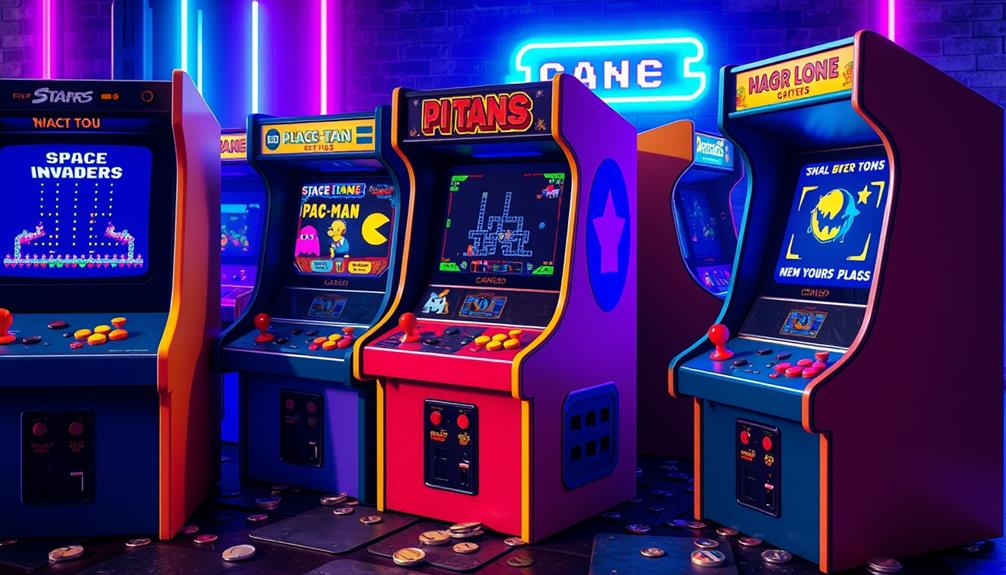
While exploring the world of arcade games, you'll find they generally fall into several distinct categories, each offering unique experiences.
Skill-based games, like *Pac-Man* and *Donkey Kong*, challenge your reflexes and strategy, allowing you to hone your skills as you play. These games can evoke intense emotional responses, reminiscent of the emotional dysregulation seen in individuals with Borderline Personality Disorder (BPD), adding a layer of depth to the gaming experience.
In contrast, gambling devices, such as slot machines and pachinko, rely on chance, giving you a different kind of thrill.
Redemption games, exemplified by Skee-Ball, reward you with tickets that can be exchanged for prizes, making them a fun choice for players of all ages.
Light gun games, like *Duck Hunt*, engage you through interactive shooting mechanics, while pinball machines combine electronic and mechanical elements for a tactile experience.
The golden age of arcade games introduced iconic titles in the shoot-em-up and platformer genres, which continue to inspire modern game design.
Additionally, driving games and claw machines provide varied gameplay experiences, catering to different interests and preferences.
Gameplay Mechanics and Features
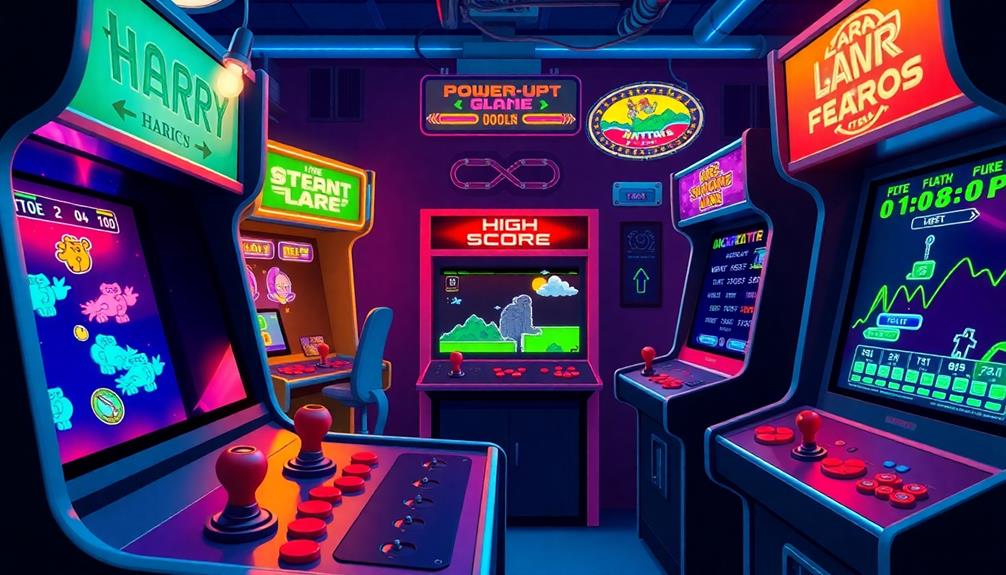
Old arcade games are renowned for their engaging gameplay mechanics and features that keep players coming back for more. These coin-operated machines offered simple yet addictive mechanics, allowing you to quickly learn and master the games. The colorful and pixelated graphics, along with the classic sound effects, provide a nostalgic retro gaming experience for players. The physicality of using a joystick and pounding on buttons adds to the immersive experience, transporting players back to a simpler time in gaming. Despite the advancements in technology, the appeal of old arcade games and the retro gaming experience they offer still persists today.
For instance, Pong's bat-and-ball dynamics set the stage for competitive play, while titles like Space Invaders and Pac-Man introduced unique gameplay styles that varied the gaming experience. Additionally, the charm associated with these games often draws on nostalgic feelings, similar to how astrology claims to influence personality traits and attractiveness.
Key gameplay features included:
- Multiple lives: Innovations like those in Space Invaders shifted your strategy and enhanced replayability.
- Rapid cycling: The average lifespan of arcade games during their golden age was just four to six months, keeping the gaming experience fresh.
- Simple controls: Easy-to-understand mechanics made it accessible for players of all ages.
- Revenue generation: The coin mechanism directly influenced arcade owners' profits, encouraging them to invest in popular titles.
These elements combined to create a fascinating environment where players could enjoy diverse experiences.
The unique gameplay mechanics in old arcade games not only entertained but also fostered competitive spirit, ensuring that you'd always find something new to challenge your skills.
Cultural Impact of Arcades
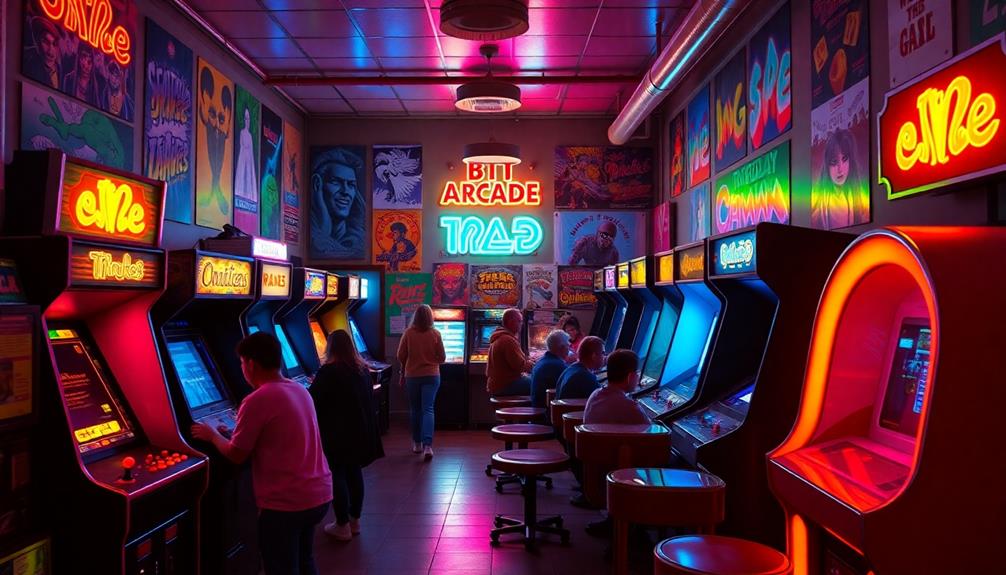
Arcades burst onto the scene in the late 1970s and early 1980s, transforming the landscape of entertainment and social interaction. The gaming boom brought iconic arcade games like *Space Invaders* and *Pac-Man* to life, creating a cultural phenomenon that resonated worldwide.
By 1982, these entertainment venues generated a staggering $8 billion in revenue, surpassing the combined earnings of the music and film industries. This shift showcased how arcade games influenced preferences and lifestyles.
You might recall the national shortage of 100 yen coins in Japan, driven by the overwhelming popularity of *Space Invaders*. Arcade gaming became deeply embedded in local economies and cultures, altering social interactions as friends gathered to compete and collaborate.
Movies like *Tron* and shows such as *The Goldbergs* reflect this nostalgia, emphasizing the lasting impact of arcade games on 1980s pop culture.
As you explore this era, you can see how the rise of arcade games contributed to a decline in the music industry, which experienced a $400 million revenue drop.
Ultimately, arcades not only changed entertainment but shaped social dynamics in ways that still resonate today.
Evolution Over the Decades
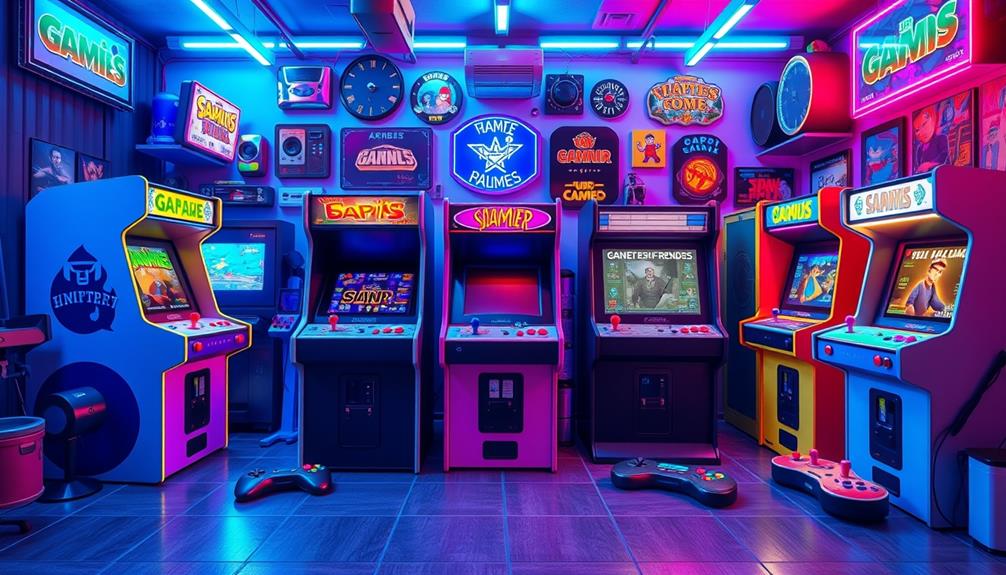
Since their inception, arcade games have evolved dramatically, reflecting changes in technology and player preferences. Classic arcade games like *Computer Space* and *Pong* kicked off the era in the early 1970s, setting the stage for the golden age between 1978 and 1983. During this time, iconic titles such as *Space Invaders* and *Pac-Man* became cultural phenomena, shaping arcade culture and attracting players from all walks of life.
As the 1980s rolled in, gaming diversified into genres like platformers and maze chase games, expanding the range of experiences available to you.
The introduction of 3D graphics in the 1990s with hits like *Street Fighter II* and *Dance Dance Revolution* breathed new life into arcades.
Through the years, despite the rise of home consoles, nostalgia for classic arcade games sparked a resurgence in the 2000s. Barcades emerged, blending gaming with adult social environments, allowing you to relive those cherished moments.
- Iconic titles defined the era
- Diverse genres kept players engaged
- 3D graphics revitalized interest
- Barcades celebrated nostalgic gaming experiences
Nostalgia and Collecting
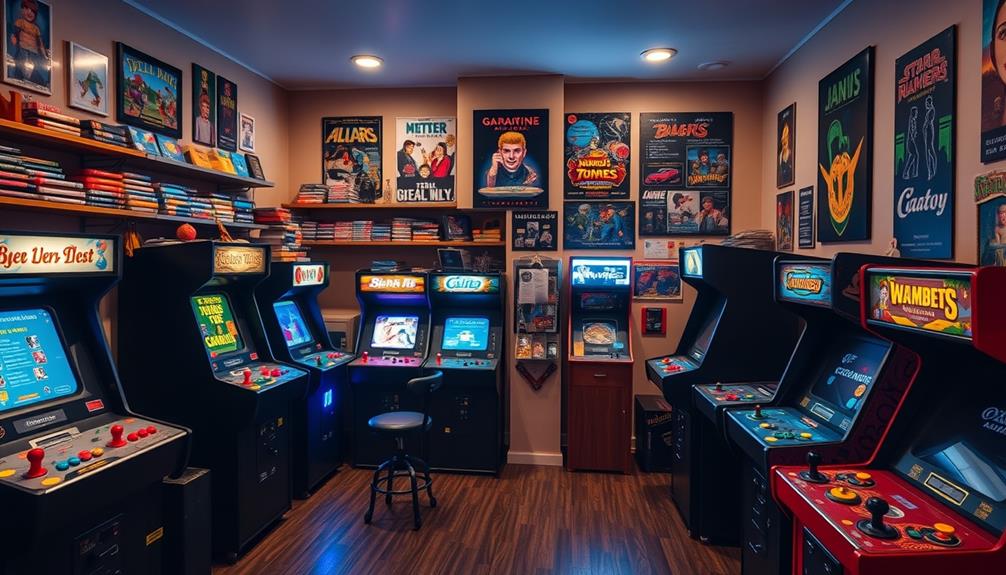
Nostalgia for vintage arcade games often pulls players back to a cherished era of gaming that thrived from the late 1970s to the early 1980s. This fondness has sparked a vibrant community of collectors who search for iconic titles like *Pac-Man* and *Space Invaders*. These games not only evoke memories but also showcase significant cultural impact, making them highly coveted.
| Game Title | Historical Impact | Current Market Value |
|---|---|---|
| Pac-Man | Cultural Icon | Up to $10,000 |
| Space Invaders | Pioneered Genres | Up to $8,000 |
| Donkey Kong | First High-Score | Up to $6,500 |
| Galaga | Classic Shooter | Up to $5,000 |
| Frogger | Family-Friendly | Up to $4,000 |
The resurgence of interest in retro gaming has led to a booming market for arcade machine restorations and reproductions. Events like arcade tournaments and retro gaming conventions celebrate these classics, fostering community among enthusiasts. Auction sites, like eBay, have become popular for buying and selling vintage arcade games, with some machines fetching impressive prices depending on their rarity and condition.
Modern Revival of Arcades

The revival of arcades has breathed new life into the gaming scene, attracting a diverse audience enthusiastic for both classic and contemporary experiences.
This modern revival of arcades has sparked the emergence of adult-oriented venues, often called "barcades," where nostalgic former gamers can enjoy classic arcade games in a social drinking atmosphere.
Here are some key aspects of this revival:
- A mix of retro arcade games like Donkey Kong and *Pac-Man* with exciting new titles.
- Competitive gaming events, particularly for fighting games like Street Fighter II.
- Themed nights and special events that foster a vibrant social experience.
- Innovations from manufacturers like Raw Thrills, creating modern versions of vintage titles.
These adult-targeted venues not only celebrate the nostalgia of retro arcade games but also integrate advanced technology and interactive experiences.
By hosting competitive gaming events and promoting a communal atmosphere, they reinforce the cultural significance of arcade gaming.
As you step into one of these arcades, you'll find a blend of the past and present, making it a great place to relive your childhood or discover something new.
Frequently Asked Questions
What Do You Call the Games in an Arcade?
You call the games in an arcade "coin-operated amusement machines." These machines come in various forms, from skill-based challenges to classic video games, all designed to entertain and engage players with exciting gameplay experiences.
What Is Another Word for Arcade Games?
Imagine stepping into a time machine filled with nostalgia. You can call arcade games "coin-operated machines," "video game cabinets," or even "redemption games." Each term captures the magic of those joyful gaming experiences you cherish.
What Are Old Games Called?
Old games are often called classics or retro titles. You'll find them featuring simple mechanics and nostalgic charm. These games, from the late 20th century, continue to captivate players with their timeless appeal and memorable experiences.
What Are the Old Video Game Machines Called?
You might call those old video game machines "arcade cabinets." They were iconic, standing tall with vibrant graphics and enchanting sounds, inviting you to insert coins and enjoy thrilling gameplay experiences that defined a generation.
Conclusion
As you wander through a retro arcade, you might spot a familiar game from your childhood, sparking memories of thrilling competition and laughter with friends. Classic arcade games, with their pixelated graphics and simple mechanics, not only shaped gaming but also created lasting bonds. It's funny how a quick game of Pac-Man can transport you back in time, reminding you of those carefree days. So, grab a joystick and relish the nostalgia—arcades are far from over!
